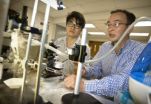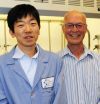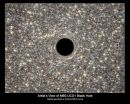Shorebird's beak inspires UT Arlington research on water collection
Process, device could help drought-stricken areas
2014-09-17
(Press-News.org) A UT Arlington engineering professor and his doctoral student have designed a device based on a shorebird's beak that can accumulate water collected from fog and dew.
The device could provide water in drought-stricken areas of the world or deserts around the globe.
Cheng Luo, professor in the Mechanical & Aerospace Engineering Department, and Xin Heng, PhD candidate in the same College of Engineering department, published "Bioinspired Plate-Based Fog Collectors" in the Aug. 25 edition of ACS' (American Chemical Society) Applied Materials & Interfaces journal. ACS also included the research in its Public Affairs Weekly release this week.
The idea began when Heng saw an article that explained the physical mechanism shorebirds use to collect their food – driving food sources into their throats by opening and closing their beaks. Luo said that inspired the team to try to replicate the natural beak in the lab.
"We wanted to see if we could do that first," Luo said. "When we made the artificial beaks, we saw that multiple water drops were transported by narrow, beak-like glass plates. That made us think of whether we could harvest the water from fog and dew."
Their experiments were successful. They found out they could harvest about four tablespoons of water in a couple of hours from glass plates that were about 26 centimeters long by 10 centimeters wide.
Shorebirds refers to a general category of bird that lives on the world's shorelines. They typically have long, hinged beaks that are designed to ferret around for prey whether in the sand or the water.
Luo said the hinged, non-parallel artificial beaks the team made in the lab mimic the shorebirds' beaks, forcing the condensation to the point where the two glass plates meet. The water is pumped through a channel, and then the process is repeated.
Luo and Heng said more sustainable methods are needed for accumulating water in arid or semi-arid places, which make up about half of the world's land mass.
"And really, if this method could be mass-produced, it could be used anywhere in the world fog or dew exist," Luo said.
Khosrow Behbehani, dean of the College of Engineering, said the research could help drought-stricken areas like Texas and California.
"The research shows innovative ideas can be triggered by careful observation of seemingly unrelated phenomenon," Behbehani said. "Collecting water from existing fog or dew using this novel method offers another alternative for communities that are strapped for our most precious resource."
INFORMATION:
About UT Arlington
The University of Texas at Arlington is a comprehensive research institution of nearly 38,000 students and the second largest institution in The University of Texas System. The Chronicle of Higher Education ranked UT Arlington as the seventh fastest-growing public research university in 2013. U.S. News & World Report ranks UT Arlington fifth in the nation for undergraduate diversity. Visit http://www.uta.edu to learn more. Follow #UTAdna on Twitter. END
ELSE PRESS RELEASES FROM THIS DATE:
Scripps Research Institute chemists modify antibiotic to vanquish resistant bacteria
2014-09-17
LA JOLLA, CA—September 17, 2014—Scientists at The Scripps Research Institute (TSRI) have devised a new antibiotic based on vancomycin that is powerfully effective against vancomycin-resistant strains of MRSA and other disease-causing bacteria.
The new vancomycin analog appears to have not one but two distinct mechanisms of anti-microbial action, against which bacteria probably cannot evolve resistance quickly.
"This is the prototype of analogues that once introduced will still be in clinical use a generation or maybe even two generations from now," said Dale L. Boger, ...
Habitual Facebook users more likely to be caught in phishing scams
2014-09-17
Washington, DC (September 17, 2014) – Receiving an email that claims you are the recipient of a large sum of money from an unknown deceased relative immediately raises a red flag. These email scams are often trashed or filtered through spam folders. But what about on social networks where there is no filter? Where people can learn about your personal life with a few clicks? A recent study published in the Journal of Computer-Mediated Communication by a researcher at the University at Buffalo – State University of New York found that people who habitually use Facebook were ...
Failed Medicare payments law remains relevant
2014-09-17
PROVIDENCE, R.I. [Brown University] — As Congress adjourns this month for the November elections, one of the killed bills senators will step over on their way out the chamber door will be the Sustainable Growth Rate (SGR) Repeal and Medicare Provider Payment Modernization Act of 2014. In a new commentary in the journal JAMA Surgery, Dr. Eli Adashi recounts what he and other advocates saw as the merits of the originally bipartisan bill. The perennial trouble with how Medicare pays doctors will return for the next Congress, Adashi said, and broader trends in health care practice ...
A massive black hole has been found at the center of an ultra-compact galaxy
2014-09-17
A team of researchers, including an astronomer from Michigan State University, has discovered a huge black hole at the center of an ultra-compact galaxy – the smallest galaxy known to contain one.
The galaxy, known as M60-UCD1, was discovered last year by a team led by Jay Strader, MSU assistant professor of physics and astronomy. Strader was a member of the team that found the black hole.
The findings are detailed in the recent edition of the journal Nature.
The finding suggests that other ultra-compact galaxies also may contain massive black holes. And that those ...
New non-invasive technique could revolutionize the imaging of metastatic cancer
2014-09-17
Bioluminescence, nanoparticles, gene manipulation – these sound like the ideas of a science fiction writer, but, in fact, they are components of an exciting new approach to imaging local and metastatic tumors. In preclinical animal models of metastatic prostate cancer, scientists at Virginia Commonwealth University Massey Cancer Center, VCU Institute of Molecular Medicine and Johns Hopkins Medical Institutions have provided proof-of-principle of a new molecular imaging approach that could revolutionize doctors' ability to see tumors that have metastasized to other sites ...
Hubble helps find smallest known galaxy containing a supermassive black hole
2014-09-17
Astronomers using data from NASA's Hubble Space Telescope and ground observation have found an unlikely object in an improbable place -- a monster black hole lurking inside one of the tiniest galaxies ever known.
The black hole is five times the mass of the one at the center of our Milky Way galaxy. It is inside one of the densest galaxies known to date -- the M60-UCD1 dwarf galaxy that crams 140 million stars within a diameter of about 300 light-years, which is only 1/500th of our galaxy's diameter.
If you lived inside this dwarf galaxy, the night sky would dazzle ...
Space: The final frontier… open to the public
2014-09-17
Historically, spaceflight has been reserved for the very healthy. Astronauts are selected for their ability to meet the highest physical and psychological standards to prepare them for any unknown challenges. However, with the advent of commercial spaceflight, average people can now fly for enjoyment. The aerospace medicine community has had very little information about what medical conditions or diseases should be considered particularly risky in the spaceflight environment, as most medical conditions have never been studied for risk in space — until now.
The aerospace ...
NASA releases IRIS footage of X-class flare
2014-09-17
On Sept. 10, 2014, NASA's newest solar observatory, the Interface Region Imaging Spectrograph, or IRIS, mission joined other telescopes to witness an X-class flare – an example of one of the strongest solar flares -- on the sun. Combing observations from more than one telescope helps create a much more complete picture of such events on our closest star. Watch the movie to see how the flare appears different through the eyes of IRIS than it does through NASA's Solar Dynamics Observatory.
The movie shows IRIS imagery focused in on material at around 60,000 Kelvin (107,500 ...
Power isn't enough: Study reveals the missing link for effective leadership
2014-09-17
NEW YORK—With the National Football League in full damage-control mode, there are many questions about how the NFL's leader handled the Ray Rice case. Was Goodell ignoring the pleas of stakeholders—former NFL players, the media and domestic violence groups—when deciding on a two game penalty? The answer may lie in a study out today by Columbia Business School.
The research, just published in Social Psychological and Personality Science, finds that leaders who fail to take into account their audiences' perspective have a far greater propensity to bungle the issue and conversation. ...
Reducing traffic congestion with wireless system
2014-09-17
At the Intelligent Transportation Systems World Congress last week, MIT researchers received one of the best-paper awards for a new system, dubbed RoadRunner, that uses GPS-style turn-by-turn directions to route drivers around congested roadways.
In simulations using data supplied by Singapore's Land Transit Authority, the researchers compared their system to one currently in use in Singapore, which charges drivers with dashboard-mounted transponders a toll for entering congested areas.
The Singapore system gauges drivers' locations with radio transmitters mounted on ...
LAST 30 PRESS RELEASES:
New software sheds light on cancer’s hidden genetic networks
UT Health San Antonio awarded $3 million in CPRIT grants to bolster cancer research and prevention efforts in South Texas
Third symposium spotlights global challenge of new contaminants in China’s fight against pollution
From straw to soil harmony: International team reveals how biochar supercharges carbon-smart farming
Myeloma: How AI is redrawing the map of cancer care
Manhattan E. Charurat, Ph.D., MHS invested as the Homer and Martha Gudelsky Distinguished Professor in Medicine at the University of Maryland School of Medicine
Insilico Medicine’s Pharma.AI Q4 Winter Launch Recap: Revolutionizing drug discovery with cutting-edge AI innovations, accelerating the path to pharmaceutical superintelligence
Nanoplastics have diet-dependent impacts on digestive system health
Brain neuron death occurs throughout life and increases with age, a natural human protein drug may halt neuron death in Alzheimer’s disease
SPIE and CLP announce the recipients of the 2025 Advanced Photonics Young Innovator Award
Lessons from the Caldor Fire’s Christmas Valley ‘Miracle’
Ant societies rose by trading individual protection for collective power
Research reveals how ancient viral DNA shapes early embryonic development
A molecular gatekeeper that controls protein synthesis
New ‘cloaking device’ concept to shield sensitive tech from magnetic fields
Researchers show impact of mountain building and climate change on alpine biodiversity
Study models the transition from Neanderthals to modern humans in Europe
University of Phoenix College of Doctoral Studies releases white paper on AI-driven skilling to reduce burnout and restore worker autonomy
AIs fail at the game of visual “telephone”
The levers for a sustainable food system
Potential changes in US homelessness by ending federal support for housing first programs
Vulnerability of large language models to prompt injection when providing medical advice
Researchers develop new system for high-energy-density, long-life, multi-electron transfer bromine-based flow batteries
Ending federal support for housing first programs could increase U.S. homelessness by 5% in one year, new JAMA study finds
New research uncovers molecular ‘safety switch’ shielding cancers from immune attack
Bacteria resisting viral infection can still sink carbon to ocean floor
Younger biological age may increase depression risk in older women during COVID-19
Bharat Innovates 2026 National Basecamp Showcases India’s Most Promising Deep-Tech Ventures
Here’s what determines whether your income level rises or falls
SCIE indexation achievement: Celebrate with Space: Science & Technology
[Press-News.org] Shorebird's beak inspires UT Arlington research on water collectionProcess, device could help drought-stricken areas



